Experiencing a disaster can be very hard, especially surviving one. Whether it be an earthquake, flood, flash flood, tornados and, of course, tsunamis. There are some important steps to be followed before, during and after a tsunami hits. All of these three stages are important and you need to be acquainted with them in advance. In this article we will talk about what to do and how to act during a tsunami.
[the_ad_placement id=”in-text-1-type-r”]Tsunamis are most common around shore and beach areas, near oceans and seas. Most often, the causes of a tsunami are earthquakes or shifting layers deep into the ocean’s bed. Usually after the first tsunami wave there may occur several more from within minutes to one hour apart.
Another reason for a tsunami is if there are volcanoes occurring on the ocean’s land surface. And after all, earthquakes, being more common in most areas, can be an early sign to prepare for the oncoming tsunami. It is estimated (and statistics show proof of it) that earthquakes take less lives than tsunamis.
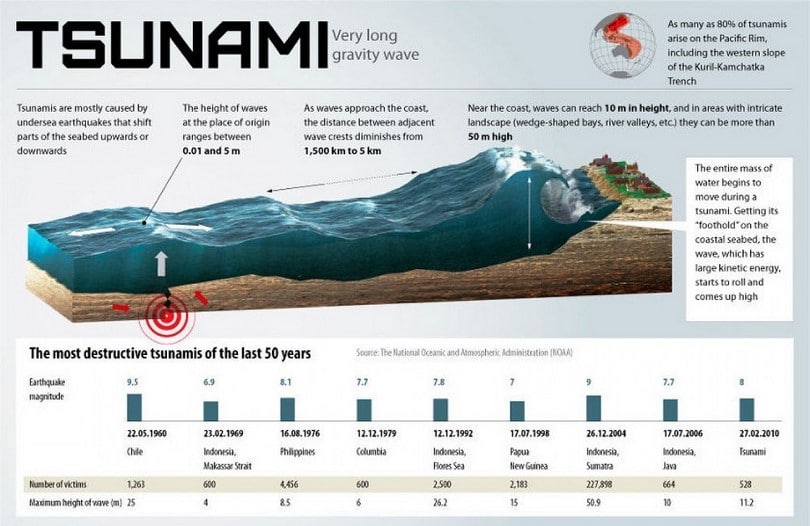
Steps on how to survive – do you really have a chance?
These steps are of vital importance, and each and every one of them can be life-saving. You need to realize that not following or disregarding one of them can be potentially fatal. All of these steps are crucial for your survival. They have been compiled and gathered thanks to real-life experiences of people who lived to see and survive a tsunami.
The first warning sign that nature itself is giving you is that coastal water levels will change. This means that a tsunami is on its way and will hit within the next hour. If you observe such signs, don’t dismiss them and react immediately. You will have some head start.
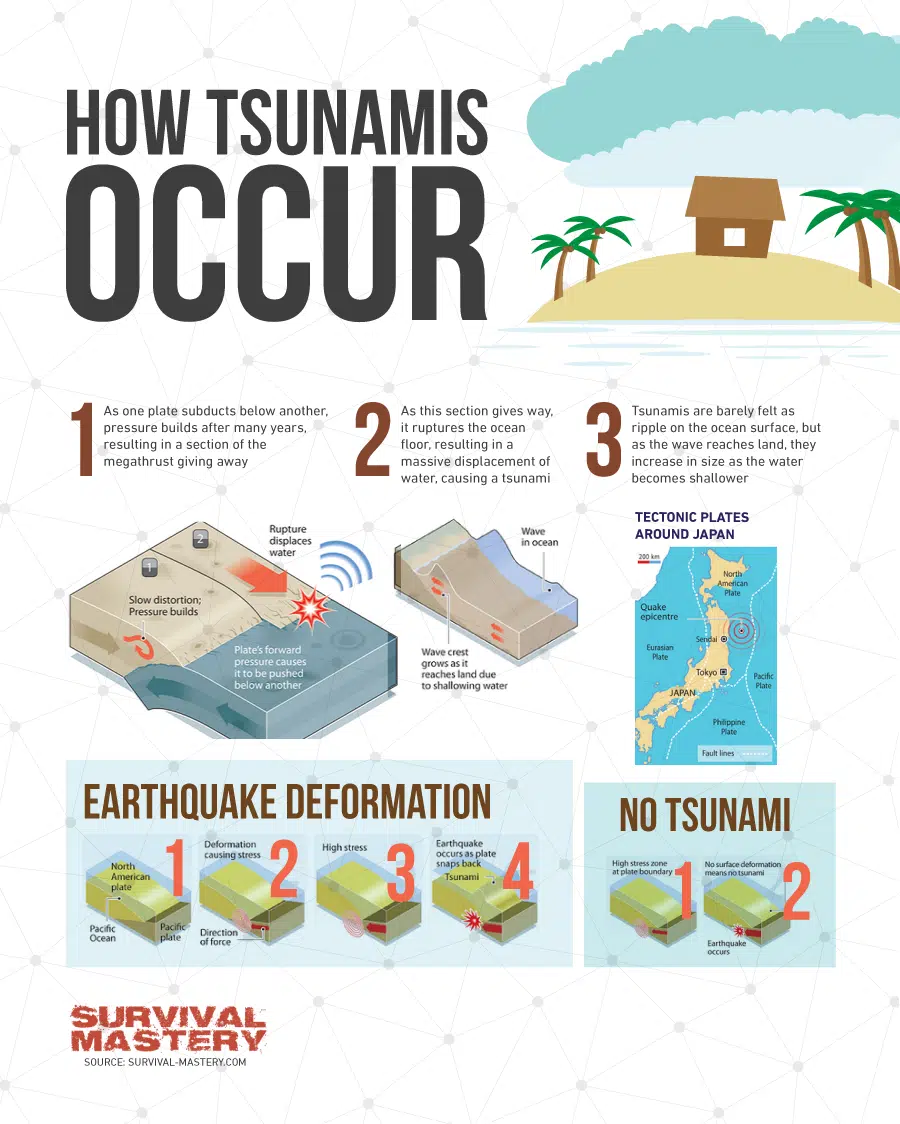
Also, warn as many people as you can while you make your way inland. Usually coastal water tends to retreat several meters in depth. As the water levels starts to rise again, then you should expect the tsunami to hit in the next few minutes. Don’t wait for the levels to rise, and evacuate when the first signs of retreating ocean levels are observed. Many people neglected these warning signs and perish as a result.
Another very important thing is that you move away from the shore as quickly as possible. Don’t wait for the wave to come closer, don’t take photos or shoot videos. Every second counts and can save your life. As you see or hear the wave, get on a bike, in any vehicle, or even simply run.
If you have no means of transportation, run to the closest elevated ground or solid building (find a tall one and climb all the way to the roof and on top of it). If you have a vehicle, move inland to at least a mile away from the shore. In most cases, water moves inland for up to a few miles at most.
As the first wave hits, you have to be prepared for more waves. Don’t expect that if the first wave is already gone, this will be the end. In fact, many experts show statistical data that the next waves can be not only stronger, but the strongest wave can be the 3rd or 4th. One such example is the tsunami disaster in Hawaii, 1960. Many people thought that after the first wave it’s safe to abandon high grounds, and they perished after being hit by the 3rd and most destructive wave.
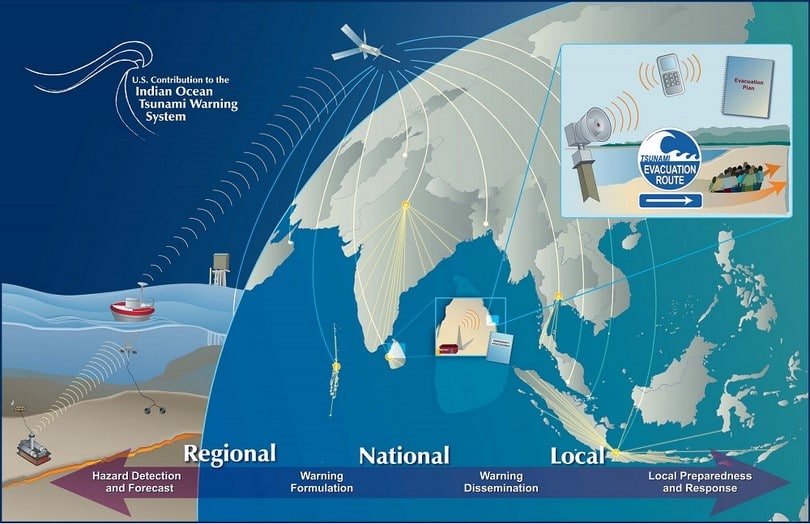
So, our advice is that you wait for several hours after the first wave and see if there are more coming. Within several hours, at least one or two may occur. It depends on the strength of the earthquake (or whatever caused the tsunami). If you are at a safe place, it would be best to stay put. If not, when the first wave is gone, move to a safer, higher place, so that the second wave won’t hit you.
This leads to the second most important thing, and it is that you move quickly. You have to be very flexible, calm and think how to move to a safer ground. Usually the safest places are high hills and mountains. If you get to such an area, stay there until everything calms down. If it is harder for you to find hills or elevated areas, even buildings or trees can be life-saving. The problem is that poorly made constructions may not withstand the full blast of a 6-meter (or more) wave.
So, if you decide to go on the roof of a building, pick one that seems stable and solid. If there are no buildings nearby where you are, and you need to react within minutes, find a sturdy tree that can withstand both you and the strong flood.
Many trees get uprooted by the water, so find one that is tall and has a thick crown. Such trees usually have deeper roots and are far more reliable. Many people report that some old thick trees saved their lives during tsunamis. It is true that the thicker the tree, the harder to uproot it, so keep that in mind. Again, we need to point out that buildings and trees are when they are your last chance of survival and provide immediate help.
Sometimes many people get caught in the flood. They didn’t have time to get to a safe place. If you get in such a situation, grab hold of anything you see floating nearby. There was a woman who reported that when the second wave hit, she was swept by its strength.
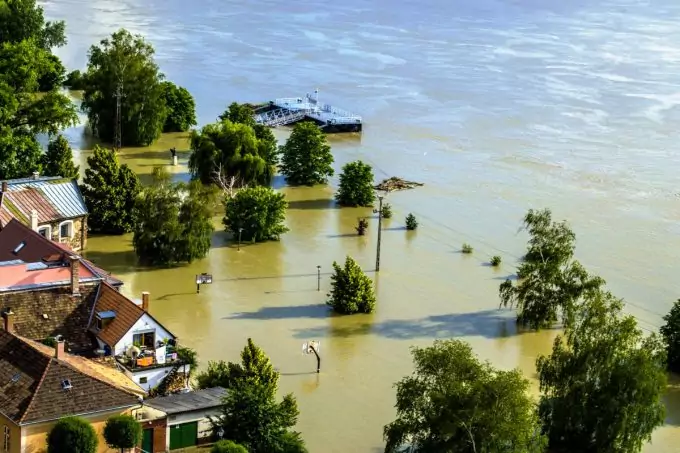
She thought that as the first wave was gone, it is safe to come back to the streets (don’t make that mistake, as we pointed out earlier). So, she managed to get hold of a log and it actually saved her life. This happened during the devastating tsunami in Chile, 1960. The woman floated on the log for about one mile away from where she was swept off.
[the_ad_placement id=”in-text-2-type-r”]Another thing that is very important is to stay off the roads. If there was an earthquake that caused the tsunami, the roads may be destroyed, with cracks, and it would be impossible to move further. You may get stuck somewhere on the road with no way of escaping or going back.
So, whatever you decide to do, keep in mind that asphalted roads may be destroyed. Find some alternative routes that you know. If you consider it taking up valuable time, abandon this plan, and simply go straightaway to a higher ground. Don’t waste time in pushing your car through muddy ground.
Also, if you manage to escape by car after all, be very cautious when you encounter water on your way. This is highly possible to happen and you need to know that six inches may get into the controls of your car and damage it. Not only that but two feet of water will carry away any type of vehicle – from the smallest and lightest to the heaviest and sturdiest. So by all means, avoid any type of moving water that is higher than 6 inches. Abandon your car or find an alternative route.
Remember another valuable advice – you have to think quickly and take with you only things of essential importance like documents, ID cards, medications, credit cards, warm clothes. Forget the rest, you can’t save all your possessions and put to risk your life. You can read more about how to put together a disaster preparedness kit for situations just like these.
Many people report how their friends or relatives decided to go back and save their money or similar valuables, and got drowned in the flood. Of course, sometimes you may have to react immediately and forget about any items at all, just think of your life as the most important and valuable possession you have. Nonetheless, at least a preparedness kit (or first-aid kit) can be extremely important so if you have some seconds to react, don’t forget it.
During the tsunami, find a way to have access to a radio or any other connection with the world. You can get updated information about the situation, about warnings, satellite images and whether there are going to be other waves. Usually media spreads quickly news about an imminent or current local disaster and spread knowledge and advice on what to do during the disaster. They give valuable information and this may be helpful during the crisis. It is also like a moral support to hear other people’s voices and boosts the morale. You should have a radio that can transmit messages from institutions like NOAA – we have a great article on how to choose the best emergency radio.
Sometimes it may occur that you’re in a public area with many people, when you hear the news. People may panic and this creates frustrating and unnerving chaos, which makes it harder to evacuate. So, keep you calm and follow the directions given by any authoritative and experienced person. There will always be people who are educated and prepared for such situations. Don’t let panic get the better of you.
At times, it may be even advisable that you just stay inside your house, away from windows (as the force of the water will break them and hurt you). If your house in only one-story and you have no time of getting to a safer ground, don’t leave the place to climb on the roof. It may be too late, and as you try and climb on top of the house, the water may sweep you away. This is far more dangerous than just staying inside close to a thick sturdy wall.
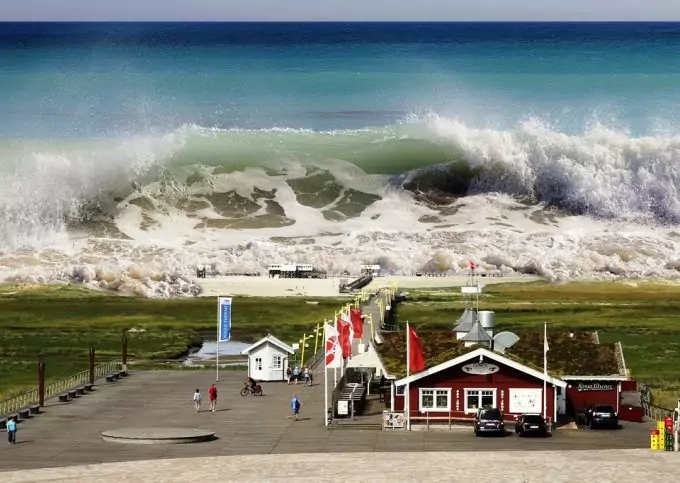
If you happen to be in an elevator, get out of it as soon as the doors open. The elevator may get stuck, due to failures in the system, electricity short circuit, etc. It is far more dangerous to be in a closed area that is out of your control. Better off use the stairs in order to get to a higher ground.
As you prepare to abandon your house and have prepared you’re most valuable items with you, don’t forget your pets, if you have any. As you evacuate your family, you may not want to leave your four-legged friends. They are much more vulnerable alone and may not make it without some help.
Evacuation process – what to do when warnings are issued
You also have to be able to recognize the difference between several tsunami alerts. Most generally they are four.
An information statement is the lowest level of danger. In this stage, the public and officials are informed that an earthquake occurred nearby. They also notify the public that another severe alert has been sent for closer areas. The purpose of these information statements is to keep people informed. In case the situation changed, the alert will be updated.
The next stage in severity is the warning. These alerts are issued to inform people that current or imminent inundation and tsunami waves are causing havoc in nearby coastal areas. These warnings help people react quickly and move inland. Evacuations may occur as you plan on leaving your house.
A watch alert is one that only informs the public of a threat of inundations or tsunami. Usually a watch doesn’t report the level of threat since it is only for the purpose of letting people know. Sometimes a watch may be updated to a warning or not at all, as the threat lowers. A watch is used for extensive analysis by officials. That helps them prepare for a potential disaster and gives them time to prepare an evacuation plan.
An advisory alert is of low status. It doesn’t expect inundations, but warns people of the imminent potential of tsunami and strong waves. When an advisory is issued people are discouraged to go to beaches, shores and coastal areas. Advisories are always followed by updates and may escalate to warnings or watches.
As you have evacuated yourself and your family, it is (as suggested) of high importance that you carry a radio with you. Knowing these four basic alerts you will be always updated about the current situation and be able to take measures according to the news and alerts. Don’t underestimate the importance of contact with the outer world. It may be of life-saving importance.
[the_ad_placement id=”in-text-3-type-r”]If a tsunami occurs during the night, the only thing that may warn you is the noise of the raging water in the ocean. If you have no visuals to see a rise or fall of the ocean’s surface, the noise is another helpful warning sign. Tune in as quickly as you can to a radio station or NOAA’s channel to hear of imminent danger or warning alerts. While you do so, grab a safety kit, clothes, important documents, and get a portable radio to continue to listen to updates on the situation.
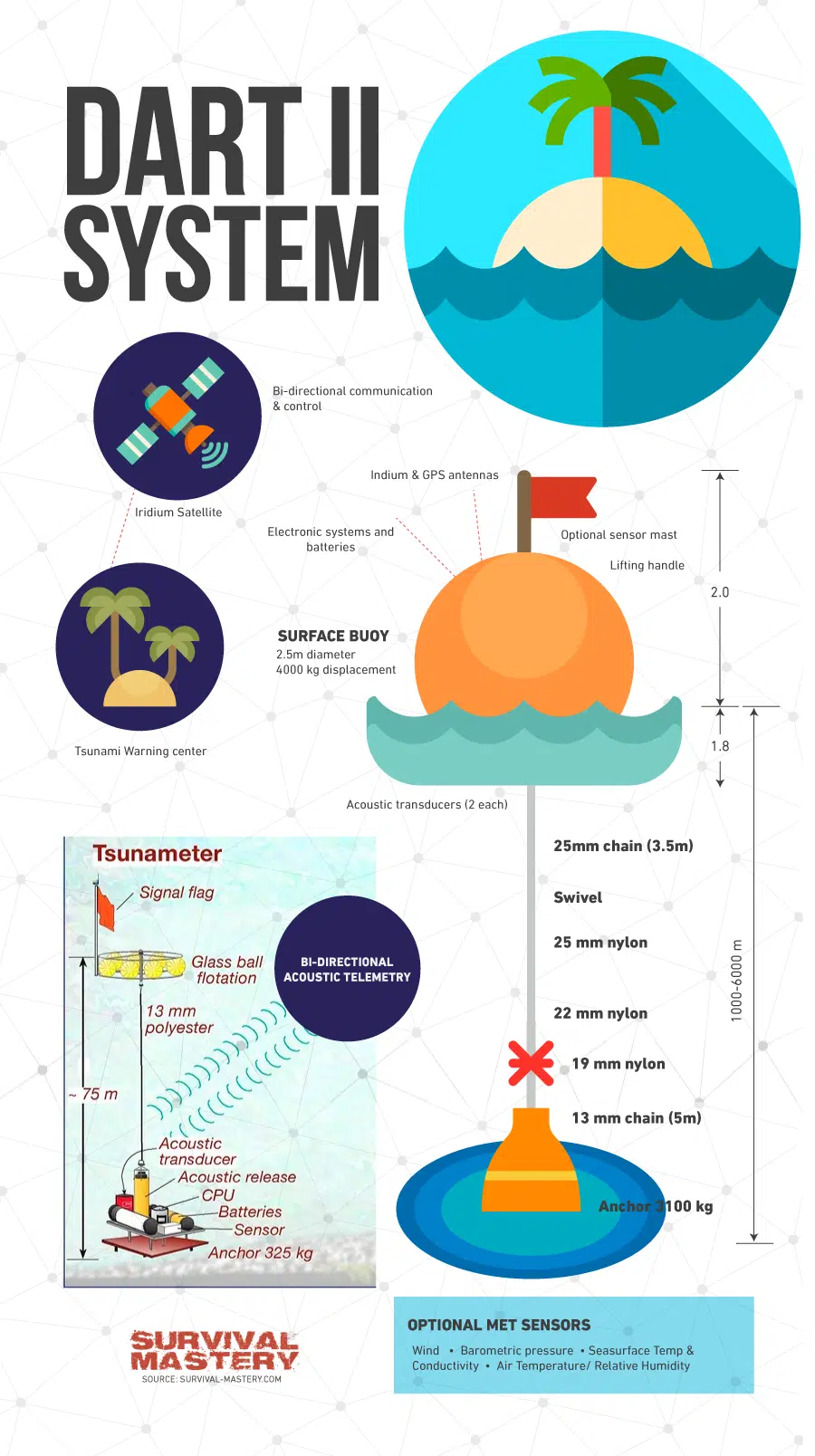
If you consider evacuating by boat, you need to know that boats are safest when the water is at least 100 feet deep. If by any chance you come across a small boat and you see no raging water nearby you may be safe to ‘travel’ by boat to the inland. It may of course be dangerous since you don’t know which areas ahead can be a threat. This is only a last measure for you to consider if the others are impossible to implement.
When we talk about boats, if you happen to be in a boat in the ocean, and recognize the signs of a tsunami, better off go deeper into the ocean. You will not be quick enough to reach the shore and run inland. The waves deeper into the ocean are not vertical. They turn deadly only in contact with land.
Most of all you need to stay calm. If you are panicked you are most likely to do irrational things and put you and others in danger. Control your emotions and put your logic and thoughts to action. You are far more likely to forget important advice if you’re stressed or panicked, than if you were calm. As long as you stay on high grounds, buildings or trees you should be safe.
Of course, don’t underestimate the importance of carrying clothes. If you get wet and have to stay put in one place for hours, hypothermia is a real danger. Many people die in such disastrous events only because they didn’t have appropriate clothes to keep warm. In many occasions when a tsunami hits people often stay away from their homes during the night. In rare locations nights can be pleasantly warm. Even if you are located in such an area during the tsunami, be aware that if you get wet, even warm weather may not prevent you from suffering hypothermal shock.
And of course, keep watch over your family members. If you stay together you’re more likely to survive and help each other, so avoid getting separated at all cost.
As long as you follow the above tips and advice, and keep calm, you have very high chances of survival during a tsunami.





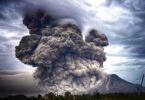
Tsunamis has reaped thousands of lives, and they’re increasing in number yearly. The best bet is preparing for them by knowing how to swim should the needs arises, by owning a boat, and keeping alert. Even then you can’t be entirely safe!
Apart from having your tsunami survival kit with you, you should always attempt to evacuate to higher grounds and do not hesitate when you get the chance.
This makes me curious, how do ships manage a tsunami attack during sailing? And is it particularly dangerous to be in a small island where a tsunami can appear and there is very little room for evacuation? Because I’ve seen this tsunami video before and they were of people vacationing on tropical islands.
It is certainly dangerous to be in a small island when a tsunami attacks. However, when it gets you there, you should aim for higher grounds. Of course, you should know how to swim among other tsunami survival skills.